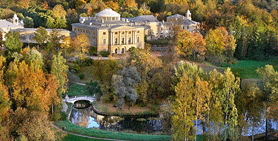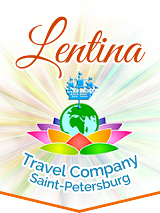
Pavlovsk is a superb palace and park ensemble spreading on a vast territory of about 525 hectares south of Tsarskoye Selo (Pushkin), in a beautiful hilly terrain along the stream of the Slavianka River - a tributary of the Neva. In 1777 Catherine the Great presented these lands to her son Pavel - as his wife gave birth to the Empress's first grandson, Alexander. Pavlovsk palace was designed by Charles Cameron using as his prototype the famous Villa Rotonda that Palladio built near Vincenza in 1552. Pavlovsk is noted for being "a work in a single style": all elements of the estate, including the palace and parks, were created in a relatively short period - between the late 1770 and the early 1800s, with no later reconstructions.
The Pavlovsk palace state rooms
The state rooms are decorated in the Luis XVI style. The rooms have a special charm due to their intimmate scale and the abundance of masterpieces of applied art made in the best factories of France and Russia. A distinctive feature of the original inner layout of the palace devised by the architect Cameron was the absence of the usual suite of state rooms and huge grand halls. Outstanding artists and sculptors were enlisted to decorate the interiors. State rooms and drawing-rooms were adorned by very rich collections of French and Russian bronze, porcelain and furniture, supplied by the foremost European makers.
The Pavlovsk parks
The Pavlovsk parks are a reflection of all the main tendencies prevailing in European landscape design around the turn of the 19th century. The main park buildings are concentrated around the palace, the surrounding landscapes create a great variety of park compositions. The boundaries between house and garden are softened by the exponents of the Regency style, introducing a fashion for open terraces and "private gardens". Landscape parks became an obligatory feature of great estates with romantic ruins as reminders of the transience of all things, temples to virtues, rural farms and aviaries that would make the aristocracy turn to productive work and encourage the correction of depraved morals. This new gardening fashion that came to Russia in 1750s, found its finest embodiment at Pavlovsk
In 1918 Pavlovsk palace and park was nationalized and began to function as a museum. During the War of 1941-45 it suffered terrible destruction. Restoration work was largely completed in 1970, although the revival of individual architectural monuments continues to this day.
Notes for the visitors of Pavlovsk palace and park
This palace and park ensemble tour is a great addition to the tour of Pushkin and Catherine's palace as it is only 15 minutes ride away. It is not as crowded as the palaces in Peterhof and in Pushkin so it is great option for those who do not want to spend a lot of time surrounded by huge crowds of tourists. You you prefer a more relaxed tour but want to visit one of the richest royal residences of St. Petersburg, Pavlovsk palace is your pick. Pavlovsk park is the largest in St. Petersburg with many small pavilions scattered on its grounds, which makes it a very nice walking area.
Closed: open daily
Duration of a tour:about 6 hours (including the drive there and back to St. Petersburg)
Official web site: Pavlovsk palace and park
Please contact us if you would like to arrange a tour.
Please see below the itineraries that cover Pavlovsk palace and park
-
This tour takes you to two Russian royal residences - Pushkin or Tsarskoe Selo, now famous for its Catherine's palace and restored Amber room and Pavlovsk, a former summer residence of Emperor Paul I and his wife.
8 hours
From: $175
-
This tour includes everything you might want to see having just 3 days in St. Petersburg! Every minute counts!
29 hours
From: $550



















